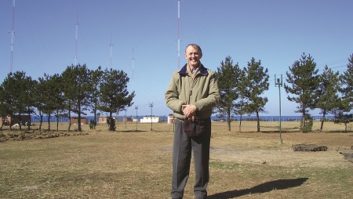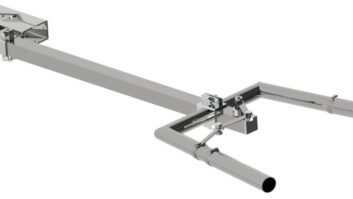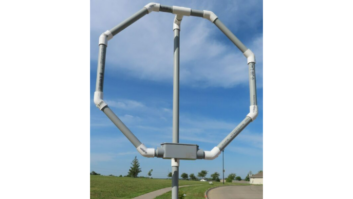Top-Loaded Cage Monopole AM Antenna Field Levels Approach Those of a Conventional Quarter-Wave
Kintronic to Seek FCC CertificationFor Kintronic labs to market the Kinstar low-profile AM antenna in the United States effectively, it likely will need the FCC’s approval.
In the past, proponents of new AM antenna system designs, including folded uni-pole, water-tower, Valcom, crossed-field, anti-skywave and umbrella antennas, have supplied the FCC with comprehensive reports, said Ed De La Hunt, associate chief of the FCC’s audio services division.
“Some have been accepted and others have not. Some continue to be tested,” he said.
De La Hunt said he was familiar with reports being filed on the Kinstar. However, Kintronic had not supplied the FCC with Rackley’s formal report on the Kinstar antenna for evaluation as of mid-March.
Tom King, president of Kintronic Labs, said the company intended to file the necessary formal document to the FCC. “We’ll move quickly to get that to them,” he said.
De La Hunt said, “If Kintronic is interested in pursuing this antenna for use in AM service, they need to file a detailed request, stating how the antenna system works, what was observed during experimentation, how it will fit within existing FCC regulations of AM antenna systems, including daytime and nighttime interference.”
De La Hunt said lacking those, a station could request to use the antenna via application. However, the device likely would only be authorized for non-directional AM use with multiple conditions placed on the station authorization.
“We would need full non-directional proofs of performance to establish the antenna minimum efficiency and non-directional characteristics and possibly current distribution requirements,” he said.
From the Kinstar preliminary report, the efficiencies appear acceptable at this point. The most difficult issues new AM antenna systems face are those of efficiency, vertical plane radiation prediction, derivation of the f (theta) formula to determine vertical plane departure characteristics, immunity to re-radiation problems and whether they can be effectively studied using existing allocation standards, De La Hunt said.
“Clearly, we need to find out more about what the antenna will do in the vertical plane or skywave performance. The nighttime propagation will tells us if protection is afforded adjacent stations,” De La Hunt said.
“Until we get to the point where it can be assured that minimum efficiencies are being met on a consistent basis, it will remain a station-by-station situation for approval.
“As often is the case, while antennas can be modeled with reasonable accuracy, the difficulties arise when you take it into the real world.”
— Randy J. StineBRISTOL, Va. Satisfied with data collected at a test site last fall, developers of the Kinstar low-profile AM antenna say they are moving forward with plans to begin selling the new technology in the United States.
Star-H Corp. and Kintronic Laboratories Inc. are partnering to develop a short electrically charged antenna suitable for applications where tower local zoning ordinances limit the height of new broadcast towers (RW, Jan. 1).
Field-strength measurements taken last fall at the Kinstar test site near Bristol, Va., were evaluated by Ron Rackley of duTreil, Lundin and Rackley Consulting Engineers. Rackley examined data collected from a standard 146-foot-tall quarter-wave monopole antenna, which was constructed, tested and then dismantled. Two configurations of the Kinstar were then built and tested in November under a special experimental license from the FCC with 250 watts on 1680 kHz near Bristol, Va. Consulting engineer Don Crane collected data for Kintronic over several weeks.
Radiation efficiencies
“It is clear from the measurement data … that the two configurations of the Star-H antenna that were tested provide effective levels approaching that of a conventional quarter-wave antenna,” Rackley wrote in his analysis.
“Each was found to have radiation efficiency well above the minimum values required by the Federal Communications Commission’s rules for Class B, C and D AM radio stations, which are 282 mV/m, 241 mV/m, and 282 mV/m at one kilometer, respectively.”
The Kinstar test antenna was 45 feet high and 105 feet in diameter over a full 120-radial ground screen and braced with wooden poles. The two configurations differed only with regard to the feedpoint arrangement.
According to Rackley’s engineering statement, “The trial A measurements were made with the Kinstar antenna’s elements fed through coaxial transmission lines of a length that was selected to provide the desired impedance transformation between their individual feedpoints and the common input point.
“The trial B measurements were made with the individual feedpoints connected together through a common conductor, without coaxial cables between the common input point and the individual elements,” Rackley wrote.
The trial A antenna outperformed the other Kinstar configuration, according to Rackley. It measured 304 mV/m, compared to 300 mV/m at one kilometer for trial B. The standard quarter-wave monopole measured 306 mV/m calculated at one kilometer.
Tom King, president of Kintronic Labs, said the Kinstar’s field strength measurements were better than the company’s computer models had indicated.
“Our computer predictions for the parallel transmission line fed antenna – trial A -were looking to be 93 percent, but were actually 98 percent as efficient as the quarter-wave monopole,” King said.
Kintronic plans to market both configurations to U.S. broadcasters, depending on the application, King said.
“There are some situations where because of voltage limitations on transmission lines that we may want to go the common version as opposed to the transmission line fed version. Cost is also a factor.
“You’re looking at a simpler match requirement with the transmission line approach, but when you get up in power you look at the tradeoff between transmission line costs and an antenna tuning unit,” King said.
Vertical pattern validation
He said the Kinstar antenna’s height will be scaleable with frequency.
“The test antenna was 45 feet tall at 1680 kHz. The height requirements will go up as you move to the middle of the AM band … somewhere around 66 feet. In the low end of the band, you’re looking at 130- to 140-foot supports,” King said.
The next step for developers is making current distribution measurements at the Kinstar test site in Virginia to validate the vertical pattern. Test results to determine if the antenna can pass the digital signal for stations using HD Radio were incomplete as of mid-March, King said.
Kintronic is designing a four-element directional array for Multicultural Radio Broadcasting station WKCW(AM) in Warrenton, Va., King said.
“They are very interested in the implementation of the array with our antenna. We have already verified on computer that we can produce the pattern with the Kinstar. We are looking at final drive points on the antenna and then we’ll be designing the feeder system for it,” King said.
Tom Casey, operations manager for WKCW, said a short antenna is an option for a new tower project.
“We are kind of in a no-growth area. They don’t like cell towers or towers of any kind. Getting the zoning approval for these kind of things has become very unpredictable,” Casey said.
WKCW broadcasts a classic country format and hopes to improve its 10 kW signal to cover neighboring Arlington, Va., and Rockville, Md.
According to Kintronic’s Web site, “Any implementation of this antenna will require an FCC mandated six-radial proof of performance together with vertical current distribution measurements.”
“(The FCC) tells us that anytime we implement the Kinstar we’ll have to go through that process to verify the horizontal and vertical pattern. We have already demonstrated that it meets the FCC’s minimum radiating efficiencies,” King said.
King said the goal is to get to the point where the Kinstar can be used anywhere in the country without going through current distribution and full proof measurements.
“It will be important for stations to avoid the additional expense, but right now it’s so new the FCC requires it,” King said.
Better than CFA?
King estimated the cost for the antenna for a station in the high end of the AM band at $10,000. “That’s up to 10 kW with ground system materials and wooden utility poles for supports,” he said.
Rackley, hired by Kintronic to examine the field measurement data, said he was satisfied with the effectiveness of the antenna.
“I was not surprised that the mechanism used for reducing ground loss in an electrically short antenna … multiple top-loaded wires … produces good efficiency,” Rackley said.
Rackley said Kintronic has succeeded where others attempting to develop short AM antennas have failed simply by getting the system built and turning it on to prove that the field strength was there.
The Kinstar doesn’t attempt to violate well-understood principles of electromagnetism, as the crossed-field antenna and some of its kin would have to in order to work, Rackley said.
Rackley said the Kinstar will be a viable choice for broadcasters confronted with height restrictions when building new broadcast towers. The one drawback he sees is that the amount of land needed to construct the antenna would be approximately the same as a conventional quarter-wave monopole.
“I believe interest in it may be somewhat limited because of that. In my consulting practice I find that more people are interested in land requirement and using as little property as possible. The new antenna won’t satisfy them,” Rackley said.
He said the FCC also will be interested in other issues, especially vertical radiation patterns.
“That is what they use to calculate nighttime skywave interference levels. So that is something that will have to be dealt with separately. Not all of the work has been completed yet,” Rackley said.
Star-H Director of Research and Development Mike Jacobs is presenting a paper on the results of the Kinstar testing program at NAB2003. The presentation is part of the “Radio Transmission Forum” on April 8, from 9 a.m. to 12 p.m. in the Las Vegas Convention Center.
King said Kintronic will have a scale model of the Kinstar in its booth inside the North Hall.
“We’ll have brochures, a video and a lot of information based on vertical and horizontal characteristics and audio bandwidth,” King said.











